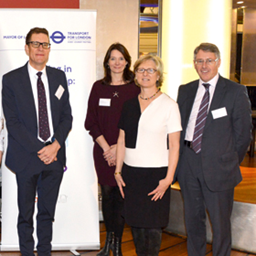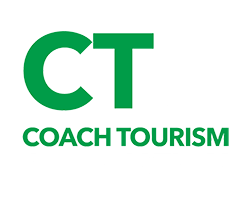The third London Tourist Coach Forum, an annual event organised as a result of the launch of the London Tourist Coach Action Plan in 2014, took place in the capital last month.
The event, held at the Prince of Wales Theatre in the West End on 18 November, was organised by the London Tourist Coach Action Board and chaired by the Confederation of Passenger Transport UK (CPT).
It was attended by local councils, industry stakeholders, coach operators, tourism organisations and London businesses.
Stephen Smith, CPT’s Operations Director, opened the Forum by speaking about the recently published CPT-commissioned Steer Davies Gleave report into the economic benefit of coaches to London’s tourism economy. He said that in 2015, 12 million domestic tourists arrived in London by coach, plus one million international tourists. Each year 21,500 tourist coaches visit central London and there are 235,000 tourist coach movements in central London. He reminded delegates that the consultation on the Ultra Low Emission Zone (ULEZ) closes on 18 December, and operators are urged to respond to it, even if they’re not based in London.
Ben Plowden, Director of Surface Transport Strategy and Planning at Transport for London, explained how coach tourism was a key part of the Mayor’s strategy of ‘A City for all Londoners’. Ben outlined that the Mayor’s focus is very much on social media and how these platforms can assist coach operators in planning their journeys and accessing coach parking facilities.
He told delegates that the new Mayor of London, Sadiq Khan, has placed air quality at the top of his agenda. Full details are in the document ‘A City for all Londoners’, which he urged people to read, and respond to the consultation, which closes on 11 December. Ben said that in terms of air quality, the new Mayor “wants to go further and faster than Boris Johnson did”.
Delegates heard about other measures being introduced by TfL, including:
– significant improvement in the flow of information about the roads network, so coach drivers can plan their trips.
– working with the CPT to inform its Twitter feed, and having a monthly column in trade magazine routeONE which is used to provide other information.
– an ongoing, and successful trial of mixed-use kerbside bays that allows coaches to drop-off and pick-up passengers at Park Lane/Cumberland Gate, Vauxhall Bridge Road and Commercial Street.
– plans to extend some current 20-minute bays to 60-minutes so that coach drivers can take their legal rest breaks.
– ongoing updates to the online version of the London coach parking map
TfL works together on all of this with Camden and Westminster councils (covering the tourist heart of the city), alongside the London Councils umbrella body; the London Tourist Coach Operators Association (LTCOA), European Tourism Association (ETOA), CPT; plus London & Partners (the capital’s official promotional company) and Society of London Theatre, representing the capital’s 67 theatres.
Cllr Heather Acton, Cabinet Member for Sustainability and Parking with Westminster City Council explained that the council’s coach provision is 68 daytime bays, using pay-by-phone, plus 16 20-minute short-term bays (free of charge) and eight overnight bays in Bullied Way. She said that around 3,000 coaches a day enter the borough, and there are 36 uses of kerbside space, from taxis, to deliveries and cycles, which means that there’s high competition for this limited resource. She told delegates that the opening of the Kingsway parking bays had been a success and, subject to TfL approval, they’ll be extended to operate from 10am to 11.59pm.
One of the biggest issues remains Buckingham Gate, due to its proximity to Buckingham Palace and the attraction of the Changing of the Guard, which, she said, creates congestion, noise and air quality issues with its use by coaches. She recognised that the ‘cat and mouse’ game of ‘circling’ to try to find drop-off points and parking increases coach movements and has air quality issues. To combat this, parking technology using the ParkRight app works with sensors to show where a free bay is, and then routes the driver to it. She said that it is hoped, subject to funding, to extend this to all coach bays in the future.
Nick Greenfield, Head of Tour Operator Relations with ETOA, and representing 200 tour operators and 650 suppliers from around the world, explained what ‘coaching heaven’ (Amsterdam) looks like, compared with coaching ‘hell’ (Italy). He took the opportunity to share some ideas of best, and worst, practice.
The vital importance of tourism to the London economy was set out in considerable detail by the London & Partners Acting CEO Andrew Cooke. He told delegates that the organisation’s strategy is economically-based, focused on ‘good growth, and tourism can help this. He said this is based on attracting visitors who spend the most, rather than those who spend little.
Against a background of three years reduced tourism since 2012, he explained that in 2015 there were 18.6m overseas visits to London, a 7% increase. With an average spend of £640 per visitor, they generated £11.9bn (up 1%).
While the US just edged ahead of France in 2015 as the biggest source of visitors (2.14m, compared with 2.07m for France), short-haul European market generates the most traffic.
But the most valuable market for London, by spend, is the USA, whose visitors spent £1.81bn – more than double the next closest, France at £0.76bn. But all this pales compared with the £8.1bn spent by the domestic market.
The Forum concluded with a lively question and answer session where the subjects included coach parking, congestion, engine idling and coaches being considered as part of key tourist location planning decisions. There was general consensus throughout the room that all parties must continue working together through the London TCAP in order to achieve these objectives.




